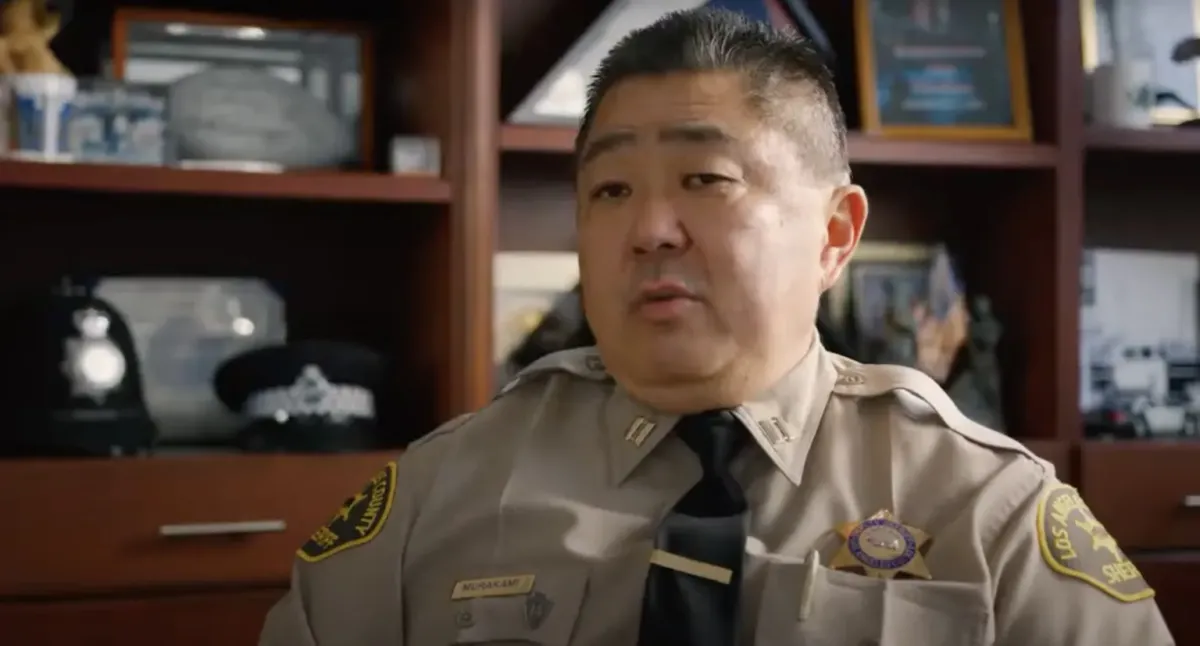
This story was published in partnership with Los Angeles Public Press.
After two years of fighting a subpoena issued by the Los Angeles County Sheriff Civilian Oversight Commission (COC), former undersheriff Timothy Murakami testified Thursday that he received the tattoo of the Cavemen deputy gang while he was a deputy at the East LA station in the 1980s.
The commission issued the subpoena to Murakami and former Sheriff Alex Villanueva in June of 2022, but they defied the order for nearly two years. Villanueva appeared willingly in January, but Murakami continued to fight it. In February, the commission sought and obtained an order from Superior Court Judge Anne Richardson ordering Murakami to appear or face contempt of court.
The COC has held 11 total special hearings on deputy gangs over the past two years. The Commission cited public revelations on deputy gangs, including Knock LA’s publication of the 15 part series A Tradition of Violence in their announcement of the investigation.
Murakami remained elusive in answering questions from Special Counsel Anthony Pacheco who was tasked with interrogating Murakami in front of the panel. Murakami often muddled pre-established facts such as the year Alex Villanueva was elected, asking a commissioner not to yell at him and refusing to answer questions directly, or at all.
Murakami also revealed he has a second tattoo, but would not answer questions about what it depicted or where on his body it is located.
The former undersheriff said only deputies who were invited could get the mark, but couldn’t identify who had invited him. He stated that like current undersheriff April Tardy, who admitted last year to having a tattoo belonging to the V Boys/Temple 5, he got it done because it “signified pride and being a hard worker.” Ironically, he also said that he had the deputy gang tattoo while working the gang suppression team at the East LA Station.
Murakami testified that he received the ink at a tattoo shop on Whittier Boulevard with a group of 6 to 10 other deputies. The ink was described as an image of Caveman carrying a club with the letters ELA (signifying the East LA Sheriff’s station) across its chest or stomach, on his right calf. Murakami’s was number 10, meaning he was one of the first 10 people to get the tattoo. He stated that he had seen others with the tattoo, but could not identify them, nor how many others had it.
Murakami could not identify any women or Black people who were members of the Cavemen, but said he thought there were some. He also testified that he did not think it would be illegal for a deputy gang to discriminate against either group. The former undersheriff also refused to answer questions about his use of racial epithets at the advice of his counsel. The County Equity Oversight Panel recommended in 2020 that Murakami be disciplined for using a Japanese language slur for Black people, but Villanueva ultimately rejected their recommendation.
Murakami’s lawyer maintained that the release of the records was a “violation of law,” despite a lawyer for the county explaining they were in fact public records.
Murakami told the commission he had his Caveman tattoo removed about 5 years ago because of “the negative media,” but believes there is nothing wrong with having tattoos like it.
Who won in the March Los Angeles City Council primary election?
by Elizabeth Chou03/06/2024 1:36 pm
Kennedy pointed out the department uses street gang tattoos as one of the criteria to make the opinion that a civilian is a gang member, but deputy gang tattoos cannot be used to determine whether a department employee is a member of a deputy gang. Murakami said he was “highly offended” by the comparison.
Pacheco inquired about Murakami’s time at the Industry station, where he worked for 20 years and rose to the rank of captain. Murakami said that he never investigated deputy gangs while at the station, although he knew about one called the Industry Indians.
The gang was recently exposed in reporting from the Los Angeles Times detailing a February 2022 incident where at least 2 members got into an altercation with teenagers at a Montclair bowling alley. Murakami said that he was not informed of the event because it “didn’t rise to the level where it would have been notified to someone of [his] rank.” He admitted that he knew the deputies and that he also knew them to be “hard working.”
When asked what he would have done if he saw a deputy with a tattoo belonging to the Industry Indians, Murakami replied, “Nothing.”
Murakami was tapped to become Assistant Sheriff of Patrol Operations by then-Sheirff Villanueva in December of 2018. He was also promoted up three ranks, skipping those in between. Murakami was one of at least two other deputy gang members recruited by the Villanueva administration.
Pacheco also asked about Murakami’s role in investigations into the Banditos and Executioners deputy gangs, a common theme across the ongoing commission hearings. Both gangs have been featured prominently in media coverage such as member assaults of deputies and killings of civilians.
In December of 2018, the department was in the midst of an investigation into a beatdown of new deputies at the hands of Banditos members at an off-duty party, which former sheriff Villanueva attended. Former division chief Matthew Burson testified at an earlier hearing that he directed internal criminal investigators not to ask questions about the Banditos. Burson also stated he was given a promotion of two ranks, skipping a rank between, one day before being given orders to not ask about deputy gangs in the investigation into the assault.
Murakami said Thursday that he spoke to Villanueva that December about promoting Matthew Burson. He also said he believed that members of the Banditos were transferred out of the East LA station, but couldn’t confirm they were in fact members.
An investigation into a deputy gang at the Compton station yielded similar results, according to Murakami. He said that a department investigation was unable to determine if the Executioners existed – but that people they believed had the tattoo were given the chance to transfer out of the station. He did not elaborate how a department investigation could determine there were no members of the group, yet there were people with the tattoo who moved to other stations.
“At both East LA and Compton we moved deputies out because of the negative association of having the tattoo,” Murakami said.
Murakami stated that he did not believe the department could discipline for tattoos associated with the Ku Klux Klan or a swastika “as long as it’s covered” because “it would be a mess.”
Murakami also stated he had the one deputy gang affiliate he freely named, April Tardy, put in charge of investigating allegations of deputy gangs at both stations. He said the department’s data on the matter was later handed over to the FBI. He also testified that he instructed the Risk Management Bureau to look at any correlation between deputy gangs and shootings by deputies, and found none.
Kennedy suggested several times throughout the meeting that Murakami may be forced to re-appear since he continually refused to answer questions. In the past, Murakami had cited a medical issue as a reason for his inability to appear. An investigation by Spectrum News 1 showed he had no such condition preventing him from testifying.
It is difficult to imagine what, if any, impact his testimony will have on LASD’s operations. The department has yet to ban deputy gang tattoos or adopt any of the COC’s recommendations to eliminate deputy gangs.
Current LA County Sheriff Robert Luna told the Los Angeles Times in December that the department drafted its own versions of the policies to eliminate deputy gangs, and had delivered it to the employee unions for their review. He did not give a date for the policies to be put in place.
